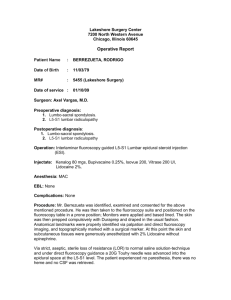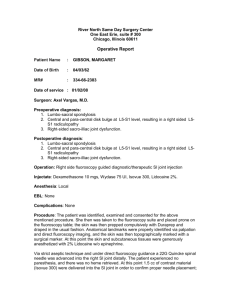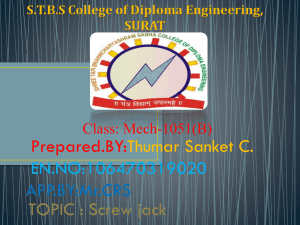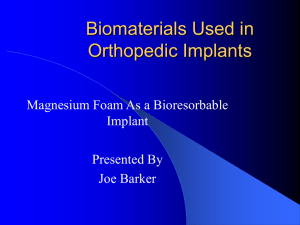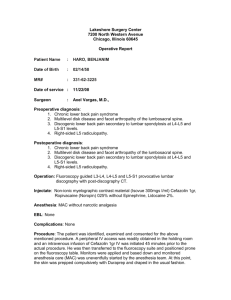Op Report 1
advertisement
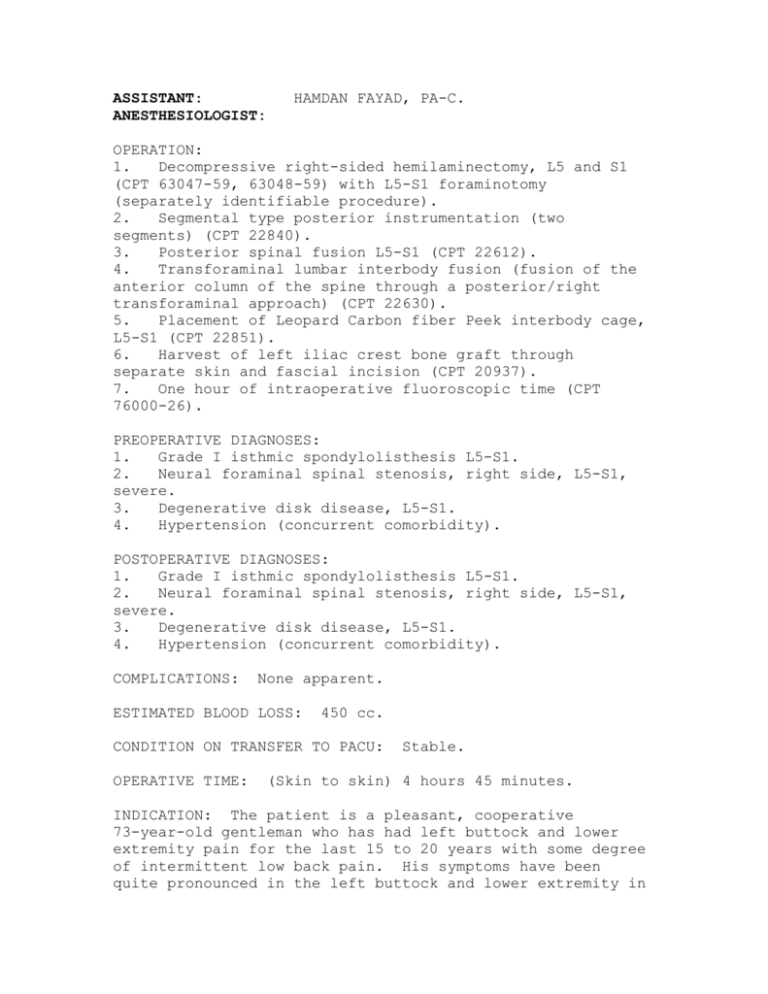
ASSISTANT: ANESTHESIOLOGIST: HAMDAN FAYAD, PA-C. OPERATION: 1. Decompressive right-sided hemilaminectomy, L5 and S1 (CPT 63047-59, 63048-59) with L5-S1 foraminotomy (separately identifiable procedure). 2. Segmental type posterior instrumentation (two segments) (CPT 22840). 3. Posterior spinal fusion L5-S1 (CPT 22612). 4. Transforaminal lumbar interbody fusion (fusion of the anterior column of the spine through a posterior/right transforaminal approach) (CPT 22630). 5. Placement of Leopard Carbon fiber Peek interbody cage, L5-S1 (CPT 22851). 6. Harvest of left iliac crest bone graft through separate skin and fascial incision (CPT 20937). 7. One hour of intraoperative fluoroscopic time (CPT 76000-26). PREOPERATIVE DIAGNOSES: 1. Grade I isthmic spondylolisthesis L5-S1. 2. Neural foraminal spinal stenosis, right side, L5-S1, severe. 3. Degenerative disk disease, L5-S1. 4. Hypertension (concurrent comorbidity). POSTOPERATIVE DIAGNOSES: 1. Grade I isthmic spondylolisthesis L5-S1. 2. Neural foraminal spinal stenosis, right side, L5-S1, severe. 3. Degenerative disk disease, L5-S1. 4. Hypertension (concurrent comorbidity). COMPLICATIONS: None apparent. ESTIMATED BLOOD LOSS: 450 cc. CONDITION ON TRANSFER TO PACU: OPERATIVE TIME: Stable. (Skin to skin) 4 hours 45 minutes. INDICATION: The patient is a pleasant, cooperative 73-year-old gentleman who has had left buttock and lower extremity pain for the last 15 to 20 years with some degree of intermittent low back pain. His symptoms have been quite pronounced in the left buttock and lower extremity in the last several months to two years that has failed to respond to conservative care. His diagnosis has been confirmed by imaging studies (C-plane from radiography and MRI). It was felt, therefore, that the above-noted procedure was indicated. PROCEDURE: After induction of the anesthetic and placement of a Foley catheter and all appropriate IVs, the patient was turned into a prone position on a Jackson table and had his lumbar spine prepped and draped in the usual sterile fashion. C-arm fluoroscopy was brought in and the trajectory of the pedicle screws marked out on the skin. Initially it had been planned to do this through a percutaneous minimal invasive approach. An incision was made to the left side of the midline in line with this trajectory approximately 3 cm long just superior to the posterior superior iliac spine. Unfortunately the appropriate retractors were not noted, and despite the fascial dissection and palpation of the appropriate landmarks, it was not felt that we could satisfactorily proceed with this type approach. Therefore, a standard midline incision was made and the posterior spine exposed in a standard fashion subperiosteally just lateral to the facet joints. The pedicles of L4 and L5 and S1 were probed and pedicle screws placed in standard fashion using biplane or C-arm fluoroscopy. The type of screws for this were the Laguna screws from the Allez spine instrumentation set. The pedicles were tapped, 45-mm length screws were placed, and EMG threshold testing performed indicating screw safety at all but the left S1 screw. This screw was removed and although the hole was palpated, not found to have any defects, it did appear to be slightly medial on the C-arm fluoroscopy and, therefore, most likely a thread or two had cut through the pedicle, resulting in this subthreshold EMG of 5 mA. Therefore, the screw hole was removed laterally by 0.5 to 1 cm, and the screw placed lateralized slightly. The screw was replaced and its threshold testing demonstrates screw safety at 10 mA. The AP and lateral fluoroscopy confirmed good alignment of the screws. A 40-mm rod was placed in the saddles of the screw on the patient's left side, distraction applied. A decompressive laminectomy was carried out of the right side of the L5 lamina (right side hemilaminectomy), and left cephalad S1 lamina sufficient to completely decompress the S1 and traversing S1 and the exiting L5 nerve roots. This was the separately identifiable decompression part of the procedure, and this part of the procedure indicated that the nerve roots were free and the decompression had been satisfactorily completed. Attention was directed to the left iliac crest through the same incision that had been used to initially place the screw trajectory, the posterior superior iliac spine was removed and osteotomized and copious cancellous bone curetted from between the tables. Crushed cancellous bone was used to reconstruct the iliac crest. Some demineralized bone matrix as well was used. The wound was then closed in layers with running #1 Vicryl suture ultimately and the skin closed with interrupted subcutaneous #2-0 Vicryl suture and then staples for the skin. This was for the lateral wound. Now the approach was made for the interbody fusion that was separately identifiable from that of the decompression. The annulus fibrosis was removed. After the annulotomy was carried out, the disk space was curetted and prepared to accept the Leopard cage. The spinous process of L5 was removed and morcellized as well. Local laminectomy bone as well as spinous process bone and celiac crest bone was placed anterior in the inner space followed by the Leopard cage that had been packed with iliac crest bone, followed by more iliac crest bone posterior to the cage in a cantilever fashion. The cage was palpated and found to be in good alignment and C-arm fluoroscopy indicated good alignment of the cage. Compression was applied to the rod on the left side, a 40 mm rod on the right side was placed and screw caps tightened and secured to the appropriate torque. AP and lateral fluoroscopy confirmed good alignment of implants. A separate 8-inch ConstaVac drain was brought out through a separate stab incision on the patient's left side. The wound was irrigated with normal saline with Bacitracin added copiously. A decortication was carried out of the left residual S1 lamina, left residual L5 lamina, and the residual pars and articularis on the left side and bone graft packed in this area to affect a posterior fusion at L5-S1 on that side primarily in the area just deep to the rod. The wounds were then closed in layers over this eighth-inch ConstaVac drain using interrupted #2-0 Vicryl suture for the fascial layer, #1 Vicryl suture for the deep fascial layer, interrupted #2-0 Vicryl suture for the subcutaneous layer, and staples for the skin. A dressing was applied, the ConstaVac placed to selfsuction, and the patient transported to the postanesthesia care unit in stable condition.
